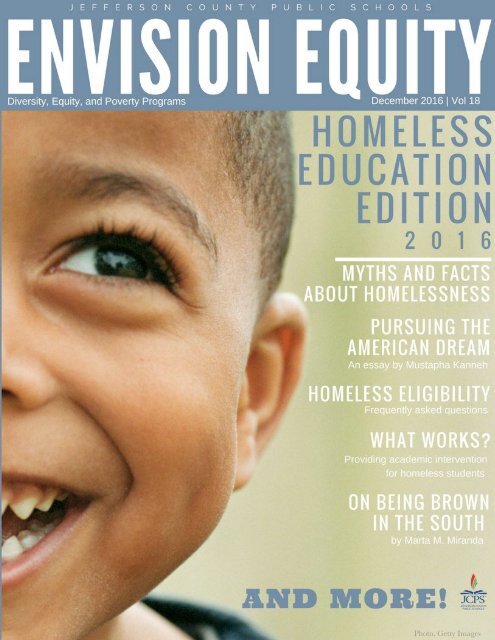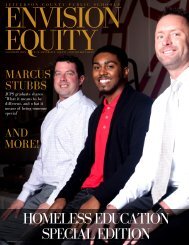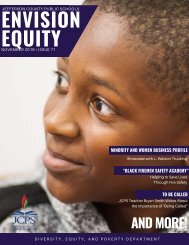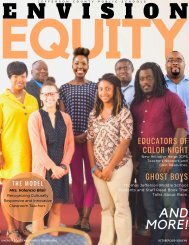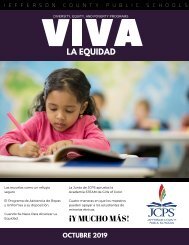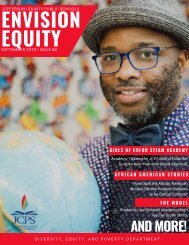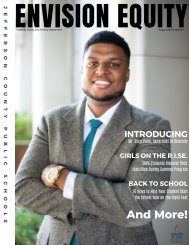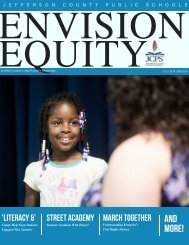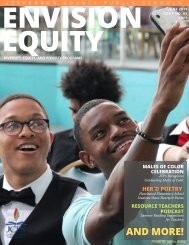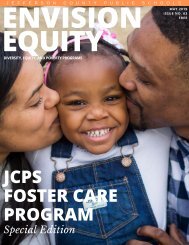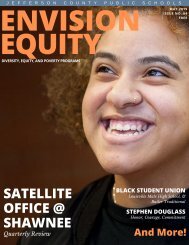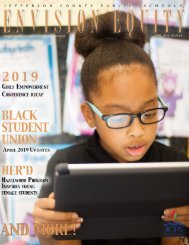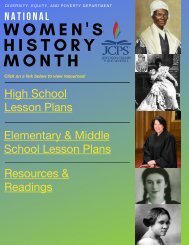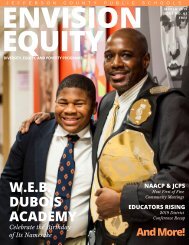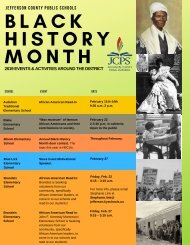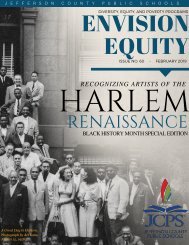Envision Equity - December 2016 Special Homeless Education Edition
We hope you enjoy the special homeless edition of our Envision Equity newsletter! Remember that Envision Equity is also your newsletter. We hope that you will submit articles that celebrate and demonstrate diversity and inclusion. As a reader, you will have access to photos from events that embody the purpose of this newsletter. Please feel free to peruse our Flickr account, which is posted under the cover page. We hope you enjoy, share, and contribute to the newsletter. Lastly, remember to envision equity.
We hope you enjoy the special homeless edition of our Envision Equity newsletter! Remember that Envision Equity is also your newsletter. We hope that you will submit articles that celebrate and demonstrate diversity and inclusion. As a reader, you will have access to photos from events that embody the purpose of this newsletter. Please feel free to peruse our Flickr account, which is posted under the cover page.
We hope you enjoy, share, and contribute to the newsletter. Lastly, remember to envision equity.
You also want an ePaper? Increase the reach of your titles
YUMPU automatically turns print PDFs into web optimized ePapers that Google loves.
1<br />
Photo, Getty Images
ENVISION EQUITY DECEMBER <strong>2016</strong><br />
The Pleasure of Serving<br />
the Most Vulnerable Families in the District<br />
By Giselle Danger-Mercaderes, MSSW, CSW, Coordinator, Student <strong>Equity</strong> and Community Engagement Program<br />
Last year, there were 6,128<br />
students identified as<br />
homeless in Jefferson<br />
County Public Schools<br />
(JCPS). How many of them<br />
actually show up, is more<br />
difficult to predict. <strong>Homeless</strong><br />
families are highly mobile<br />
and for that reason are often<br />
difficult to track. Often<br />
times, families facing<br />
housing instability and<br />
homelessness keep their<br />
situation a secret because of<br />
the stigma attached to the<br />
world “homeless.” The<br />
reality is very different from<br />
what some people appear to<br />
believe. The negative stigma<br />
attached to homelessness is a<br />
reality in every school in our<br />
district and is played out in lunchrooms, school buses,<br />
playgrounds, libraries, science labs and math classes.<br />
Every day a JCPS student sits at his or her desk trying to<br />
learn how to read, while wondering where they will go<br />
after school ends.<br />
Since the school year began in August, the Parker family<br />
(using a pseudo name to protect their identity) has moved<br />
four times, and the elder child of the family has requested<br />
“dropout papers” a couple of times to help the economy<br />
of the household. So far we (teachers, school counselor,<br />
transportation coordinator and homeless liaison), have<br />
been able to keep the students in their same school and<br />
have been able to support them with available resources,<br />
however we know we are unable to address the main<br />
barrier that the family is experiencing--lack of affordable<br />
housing.<br />
In JCPS, our staff members wrestle with non-academic<br />
barriers that have a significant affect on the academic<br />
development and wellbeing of our students. Our efforts<br />
are visible in the school’s supply closets, where<br />
toothbrushes and deodorant are stored along with pencils<br />
and paper. Our efforts are visible in the desk of nearly<br />
every teacher, where healthy snacks for a hungry student<br />
are stashed away. Our efforts are visible in the Office of<br />
the district’s homeless liaison, where we strive to be social<br />
workers, advocates, therapists and even Santa Claus. Our<br />
efforts are visible in<br />
the Diversity, <strong>Equity</strong><br />
and Poverty<br />
Department, where<br />
collecting funds for a<br />
struggling family is<br />
very common. I am<br />
so proud to work<br />
alongside team<br />
players that fight to<br />
improve the test<br />
scores, living<br />
conditions, and<br />
overall well-being of<br />
our homeless<br />
students.<br />
Last year alone, The<br />
Student <strong>Equity</strong> and<br />
Community<br />
Engagement<br />
department distributed<br />
shoes, gave away backpacks, school supplies, holiday<br />
presents, computers and uniforms to homeless families.<br />
We also provided tutoring after school, and during spring<br />
and summer breaks. Our dream is to be able to open a<br />
drop-in center for families experiencing homelessness<br />
where students can receive tutoring, counseling,<br />
homework, case management assistance and parents can<br />
be supported in becoming school advocates and selfsufficient.<br />
Above, Giselle Danger-Mercaderes assists students at a homeless shelter’s after-school<br />
program. Photo, Louisville Magazine.<br />
The Student <strong>Equity</strong> and Community Engagement<br />
department supports homeless students though local and<br />
federal funds. However, often times we find ourselves<br />
wondering what we can do when the need is larger than<br />
available resources.<br />
They may call me the “beggar liaison.” Everywhere we<br />
go, I say, “I need, I need, I need for my families and my<br />
kiddos.”<br />
We are so grateful for all the support we received from our<br />
community.<br />
For information on a drop off day Student <strong>Equity</strong> and<br />
Community Engagement Program and other ways to help<br />
homeless students contact us by email: giselle.dangermercaderes@jefferson.kyschools.us<br />
2
ENVISION EQUITY DECEMBER <strong>2016</strong><br />
Pursuing<br />
the American Dream<br />
By Mustapha Kanneh, JCPS Parent<br />
My name is Mustapha Kanneh. I was born into the union<br />
of Mr. Mustapha Kanneh and the late Ms. Lydia Gardee<br />
Kermokai in Paynesville, Montserrado County, Liberia. My<br />
father has ten children, five boys and five girls. I am the first<br />
boy of my father and mother and first child for my mother. In<br />
1987, we lost our young mother while she was in labor with our<br />
last sister.<br />
I started primary school in 1984 at<br />
the God of Mercy Elementary<br />
School and completed high school in<br />
1999 at <strong>Special</strong> Project High School,<br />
Gardnesville, Liberia. As I grew up with<br />
the love for science, I enrolled at the<br />
University of Liberia, College of Science<br />
and Technology in 2000 where I studied<br />
Biology as major and Chemistry as a minor. During my enrollment,<br />
Liberia was still in political struggle and civil war, causing delay in my<br />
enrollment. In 2009, I graduated with a Bachelor of Science Degree in<br />
Biology.<br />
Moreover, before my graduation from the University of Liberia, I<br />
started working as a volunteer at the Department of Preventive Health,<br />
Ministry of Health & Social Welfare, Monrovia, Liberia and was later<br />
employed as Non Communicable Diseases Deputy Coordinator in 2007.<br />
With the passion to serve humanity and save lives, I sat the Medical<br />
College Admission Test (MCAT) at A. M. Dogliotti College of Medicine,<br />
University of Liberia, 2009. Unfortunately I did not meet the score and<br />
later sat the Graduate Record Examinations (GRE) at Cuttington<br />
University, Graduate School and Professional Studies. I enrolled in the<br />
Public Health Program and graduated with Master of Public Health<br />
Degree in Epidemiology in 2011.<br />
When I was a little boy I had always imagined how the United States of<br />
America would look, especially when we watched television and movies. I<br />
thought everything in the U.S. was so easy, free and one could get them at<br />
any time they wanted. It was always my dream to travel and enjoy the<br />
colorful pictures, lights, beautiful buildings and cars I saw in movies and<br />
TV.<br />
3<br />
Continued on next page
ENVISION EQUITY DECEMBER <strong>2016</strong><br />
Furthermore, as I grew up into my teens in high<br />
school, I read about some African personalities<br />
that traveled to the United States (U.S.). They<br />
lived, worked and were educated and served as<br />
world leaders in various capacities. For example,<br />
the current<br />
President of<br />
Liberia,<br />
Madam<br />
Ellen<br />
Johnson<br />
Sirleaf<br />
traveled to<br />
the U.S. in<br />
1961 to<br />
continue<br />
Madam Ellen Johnson Sirleaf. Photo, google<br />
images.<br />
her studies<br />
and earned<br />
an associate<br />
degree in<br />
accounting<br />
at Madison<br />
Business<br />
College, Madison, Wisconsin, and later studied<br />
economics and public policy at Harvard's John F.<br />
Kennedy School of Government from 1969 to<br />
1971, gaining a Master of Public Administration<br />
degree. She is the first elected female President in<br />
Africa and was jointly awarded the 2011 Nobel<br />
Peace Prize with Leymah Gbowee of Liberia<br />
and Tawakkol Karman of Yemen.<br />
How I got to America with my family<br />
Using our president and some notable African<br />
Americans as role models, I started thinking and<br />
exploring means to travel to any developed<br />
country like the United States, United Kingdom<br />
or Australia with a goal to reside, go to school,<br />
graduate and work to serve humanity as health<br />
worker or care giver.<br />
I started applying for scholarships and playing the<br />
yearly Diversity Visa (DV) lottery and was not<br />
successful. Finally, in 2013 I played and won the<br />
DV with my wife and two kids and we obtained<br />
immigrant visas at the Embassy of the United<br />
States, Monrovia, Liberia and migrated to the US<br />
in 2015.<br />
Troubles faced in America<br />
JFK Airport. Photo, google images.<br />
The first trouble was traveling from Liberia to the<br />
U.S. We spent 24-hours both in flight and<br />
transiting in Casablanca, Morocco. We arrived at<br />
John F. Kennedy Airport in New York at 6 p.m.<br />
and slept on the floor to wait on a connect flight to<br />
Chicago and to Louisville, Kentucky. We came to<br />
Louisville through one of my school mates from<br />
the University of Liberia. We were hosted<br />
peacefully for the first week. After that week, we<br />
started facing problems with our host with<br />
providing food, asking for the room we slept in,<br />
stopping my kids from playing in the house and<br />
restricting my wife and kids.<br />
Moreover, I left my office job where I worked as a<br />
public health professional and had to seek a job at<br />
a warehouse in the U.S. My sleeping time changed<br />
from 9 p.m. to 6 p.m. because I had to go to work<br />
at 3 a.m. every morning.<br />
One day, I came home from work and my smaller<br />
child was so sad and had no freedom to play. I<br />
immediately called my wife in the room and told<br />
her that it was time to find our own home.<br />
Because we had planned to move, I used to go to<br />
work without food for the whole day and return<br />
home before eating. After work, I had to run to<br />
some offices to ensure my wife and kids had their<br />
social security cards, green cards, state i.d. and<br />
driver’s license. My kids had to register for school,<br />
Continued on next page<br />
4
ENVISION EQUITY DECEMBER <strong>2016</strong><br />
sign up for health insurance and complete their<br />
immunization shots.<br />
Help We Received<br />
Louisville, Kentucky. Photo, google images.<br />
My family and I had no relatives in Louisville. We<br />
were highly depending on God for his blessings,<br />
grace and mercy. One day, we went to a Jefferson<br />
County Public Schools (JCPS) office to register my<br />
kids for the Early Childhood program where we<br />
met a lady named Kathy. She was very friendly,<br />
and by helped us register our kids in school. She<br />
also asked us to meet with the <strong>Homeless</strong><br />
<strong>Education</strong> Program for assistance. It was at this<br />
time that we met with Giselle, Christy, Julie and<br />
Chrystal. We talked and they grew interested in<br />
assisting me and my family. They helped my wife<br />
apply for food stamps and the Free Application for<br />
Federal Student Aid (FAFSA), which she was<br />
successful in obtaining.<br />
nursing. Second, I would like to work in the<br />
healthcare sector to build my capacity in clinical<br />
and try to work in the field of public health and<br />
health administration so as to be able to meet my<br />
goal and dream. I would also like to work with the<br />
U.S Center for Disease Control and Management<br />
and then end up with any United Nations<br />
organization.<br />
Goals and dreams for future<br />
My goal and dream for the future is to serve<br />
humanity and to become a diplomat. In doing so,<br />
I will be grateful to work with International Non<br />
Governmental Organizations (NGOs) like World<br />
Health Organization (WHO), United Nations<br />
International Children’s Emergency Fund<br />
(UNICEF), United Nation <strong>Education</strong> Scientific<br />
Cultural Organization (UNESCO) and World<br />
Food Program (WFP). I believe that by working in<br />
one of these institutions, I will learn to make<br />
excellent decisions and ensure that the institution<br />
implements activities that will impact humanity as<br />
a whole.<br />
While we were sleeping on the floor in our home,<br />
Gisselle’s office assisted us with finding beds as well<br />
as living room chairs. They also visited us at home<br />
and assisted my wife and kids in obtaining their<br />
lost green cards. Our thanks and appreciation to<br />
Julie who introduced my family to her church,<br />
Kinwood United Methodist Church which<br />
adopted us as a family.<br />
Outlook on Future<br />
As we live, work and get educated in the United<br />
States, I pray that the almighty God bless us with<br />
good health, peace and education. My purpose for<br />
coming to the U.S was to get a quality education<br />
by enrolling in one of the top Universities in the<br />
country. I plan to first enroll in the school of<br />
5
ENVISION EQUITY DECEMBER <strong>2016</strong><br />
On<br />
Being<br />
Brown<br />
in the South<br />
By Marta M. Miranda, Chief Empowerment<br />
Officer, The Center for Women and Families<br />
“Excuse me, ma’am, do you know<br />
that you have to be a citizen to vote in<br />
this country?” a beautiful older man<br />
with cracked sun-burn skin and a<br />
John Deere hat asked me. I stood in<br />
line after showing him the appropriate<br />
documentation.<br />
I wonder if he carries his citizenship<br />
papers with him, do you?<br />
His Appalachian drawl and reserved<br />
look let me know that he was a native<br />
protecting his own. I recognized the<br />
papa bear in him. I am sure that his<br />
experience of Latinos has been<br />
limited to seasonal migrant workers<br />
whom he hires to pick tabacci from<br />
his now bankrupt farm.<br />
I attempt to rationalize my hurt, to<br />
bridge the split in my heart between<br />
my immigrant self and my<br />
Appalachian neighbor. It is too late,<br />
the feeling of alienation and<br />
homelessness fills my throat.<br />
worn mountains and these salt of the<br />
earth people, his and mine are my<br />
connection to America. I find the<br />
racism ironically painful when it’s in<br />
the faces that touched my rural<br />
Cuban heart enough to take the oath<br />
of citizenship after many years of<br />
exile.<br />
Once I saw the beauty of these old<br />
and worn mountains, the smiling<br />
gentle face of a mountain man selling<br />
vegetables from the back of his pickup<br />
truck, and I heard him play his<br />
dulcimer, I knew I had found home.<br />
One of my fondest memories is what<br />
he said as I walked away he looked at<br />
me and said:<br />
“Well, honey, you are a cuter than a<br />
speckled puppy. Come back and see<br />
me sometime.”<br />
As the latest group of<br />
immigrants in search of<br />
the American Dream,<br />
Latinos have become the<br />
latest targets of blame.<br />
Marta M. Miranda<br />
separatist lesbian friend requests as we<br />
plan our latest revolutionary potluck.<br />
These comments along with the<br />
familiar question of my students of<br />
“do you speak Cuban?”, along with<br />
faculty members handing me dirty<br />
coffee cups at the reception for those<br />
of us who were privileged enough to<br />
be granted tenure are ever present<br />
signs of the ignorance and invisibility<br />
of the diversity of Latinos in the<br />
South. Here we are exotic, sometimes<br />
erotic and most of the time a curious<br />
commodity to stereotype and<br />
scapegoat.<br />
You see, Kentucky is my home, these<br />
I knew then that I could be an<br />
American, a Cuban-American, as<br />
long as I could live in Kentucky.<br />
“Hey Marta, can you make us some<br />
tacos?” My liberal upper class white<br />
As the latest group of immigrants in<br />
search of the American Dream,<br />
Latinos have become the latest targets<br />
of blame.<br />
6
ENVISION EQUITY DECEMBER <strong>2016</strong><br />
We proudly carry the shame of corporate excess on<br />
our backs. We take our grungy dollar bills to the<br />
largest Walmart in search of legitimacy.<br />
Our males stand around in their brown and bronzed<br />
skin wearing Nike high tops, Levi jeans and smoking<br />
Marlboro cigarettes. They create a sense of<br />
community using as a backdrop the foreign landscape<br />
of concrete parking lots. Our women and girls, go<br />
home with the large plastic bags of purchased dreams<br />
that they will mail to the less fortunate ones left behind.<br />
Immigration trends predict that Latinos will be the<br />
United States largest minority group. At the same time<br />
that visibility of brown bodies emerges, so does the<br />
degree and frequency of racism, xenophobia and its<br />
companions, hatred and violence. So does the<br />
resentment of our African-American brothers and<br />
sisters toward us.<br />
We live in<br />
the<br />
richest<br />
country<br />
in the<br />
world,<br />
but we<br />
operate<br />
on the<br />
politics of<br />
division<br />
and the<br />
fear of scarcity. United by our poverty, hard work,<br />
marginalization and varying hues of onyx skin, we<br />
stand divided by the fear of not having enough. We<br />
fight each other for the small size of the pie given to us,<br />
let’s unite and request our fair share of the bounty.<br />
Basic human services such as health care and<br />
education are repeatedly questioned or denied to us.<br />
You see, right now most of us are not only brown but<br />
also poor, speak little English and are working two to<br />
three jobs to give our kids a chance at the American<br />
dream, just like every other immigrant group who first<br />
arrived on this soil.<br />
The Italians easily took to me, probably due to my light<br />
skin and straight hair.<br />
I consider myself very privileged.<br />
Despite my high school guidance counselor’s advice to<br />
give up a scholarship to Montclair State College and<br />
settle for vocational school, I have been able to claw my<br />
way up the ladder of post-secondary education. I now<br />
have the opportunity to carry the flag for The Center<br />
for Women and Families, a multi-million dollar nonprofit<br />
that serves survivors of domestic violence/sexual<br />
assault and their families. In solidarity with the young<br />
prostitutes, gang members and heroin addicts in my<br />
Jersey neighborhood, I, by the mystery of exception,<br />
enjoy a safe, drug free and educated lifestyle.<br />
One of my<br />
greatest<br />
blessings is my<br />
deep reverence<br />
for multiple and<br />
complex selves.<br />
I am a lot, we<br />
Marta M. Miranda<br />
are all a lot. I<br />
refuse to compartmentalize myself to fit the boxes that<br />
have no room for all that is precious in me.<br />
How do we connect the dots of systematic oppression<br />
and not split ourselves? How do we not leave others<br />
like us and most importantly those who are different<br />
from us behind?<br />
At this point, I don’t know. I guess like my<br />
Appalachian neighbor would say: “I’ll study on it.”<br />
For me personally, these Appalachian mountains are<br />
my home. I was raised in Pinar del Rio, Cuba until<br />
age 12. I immigrated to New Jersey under the auspices<br />
of a sponsor family in 1966. I loved and fought hard<br />
alongside my Newyorcians and African American<br />
friends. I have always been a scrapper.<br />
7
ENVISION EQUITY DECEMBER <strong>2016</strong><br />
The Importance of<br />
the Residency Form<br />
Requirements<br />
By Giselle Danger-Mercaderes, MSSW, CSW, Student <strong>Equity</strong> and<br />
Community Engagement Program<br />
The Student <strong>Equity</strong> and Community Engagement<br />
(formerly known as The <strong>Homeless</strong> <strong>Education</strong> Program),<br />
provides schools with the JCPS Student Residency Form.<br />
This form is an excellent tool that allows for every<br />
homeless child and youth to be sensitively identified,<br />
permitted admission in an immediate and sensitive<br />
manner, and to be enrolled in and attend school on a daily<br />
basis. This form was recently updated and the old<br />
residency form is no longer valid. Every JCPS student<br />
must complete this form to ensure eligible families are able<br />
to be identified for services.<br />
Students identified as homeless are protected and<br />
are able to continue in the school they attended when<br />
permanently housed or the school in which last enrolled if<br />
that is the parent’s or youth’s choice. They are also eligible<br />
to receive transportation to their school of origin. The<br />
information contained in the Residency Form is kept strictly<br />
confidential. The Completion of this form may qualify students for<br />
further educational and financial assistance through Title I - Part A<br />
or Title X - McKinney-Vento but will not compromise their current<br />
school enrollment.<br />
8
ENVISION EQUITY DECEMBER <strong>2016</strong><br />
New Federal and District Level<br />
Provisions Related to the <strong>Education</strong> of<br />
<strong>Homeless</strong> Children and Youth.<br />
By Giselle Danger-Mercaderes, MSSW, CSW, Student<br />
<strong>Equity</strong> and Community Engagement Program<br />
On <strong>December</strong> 10,<br />
2015, President<br />
Obama signed into<br />
law the Every<br />
Student Succeeds Act<br />
(ESSA),<br />
reauthorizing the<br />
Elementary and<br />
Secondary <strong>Education</strong><br />
Act (ESEA). This Act<br />
strengthens the Elementary and Secondary <strong>Education</strong> in<br />
remarkable ways, including new requirements related to<br />
the education of homeless children and youth.<br />
Most ESSA amendments to the McKinney-Vento Act<br />
(the Act defines and protects the rights of homeless<br />
students) went into effect on October 1, <strong>2016</strong>. The JCPS<br />
Student <strong>Equity</strong> and Community Engagement<br />
Department has been working diligently to update<br />
existing resources to reflect changes made by ESSA. As a<br />
results the district has updated their Admissions and<br />
Attendance and a new JCPS <strong>Homeless</strong> Policy Guideline<br />
has been created.<br />
The Jefferson County Public School District is dedicated<br />
to ensuring all students experiencing homelessness<br />
(McKinney-Vento eligible students) have “equal access to<br />
the same free, appropriate public education, including a<br />
public preschool education, as provided to other children<br />
and youths” in accordance with the McKinney Vento<br />
<strong>Homeless</strong> Assistance Act (reauthorized under the Every<br />
Student Succeeds Act, <strong>December</strong> 10 th 2015). It is the<br />
policy of JCPS that every homeless child and youth be<br />
sensitively identified, permitted admission in an<br />
immediate and sensitive manner, and enrolled in and<br />
attend school on a daily basis as required by federal law.<br />
According to the McKinney Vento law and JCPS district<br />
policy a student experiencing homelessness is defined as a<br />
child or youth who lacks a fixed, regular, and adequate<br />
nighttime residence. This includes a child or youth who<br />
is living:<br />
a. With a friend, relative, or someone else due<br />
to economic hardship, loss of housing, or a<br />
similar reason.<br />
b. In a motel, hotel, trailer park, or camp<br />
grounds due to lack of alternative<br />
accommodations.<br />
c. In an emergency or transitional shelter.<br />
d. In a public or private space not ordinarily<br />
designed for or used as a sleeping<br />
accommodation.<br />
e. In a car, park, abandoned building, bus or<br />
train station, substandard housing, or similar<br />
setting.<br />
2. Children and Youth Experiencing <strong>Homeless</strong>ness<br />
have the right to:<br />
a. Go to school, including public preschool, no<br />
matter where they live or how long they have<br />
lived there.<br />
b. Continue in the school of origin (The school<br />
attended when permanently housed or the<br />
school in which last enrolled) if that is the<br />
parent’s or youth’s choice.<br />
c. Receive transportation to and from the<br />
school of origin.<br />
d. Enroll in school immediately even if<br />
documents normally required for enrollment<br />
are missing.<br />
e. Enroll and attend classes while the school<br />
arranges for the transfer of immunization<br />
records or any other documents required for<br />
enrollment.<br />
f. Enroll and attend classes in either the school<br />
of origin or the reside school even while the<br />
school and parent or youth seek to resolve a<br />
dispute over the selected school.<br />
g. Receive the same special programs and<br />
services, if needed, as provided to all other<br />
students served in these programs.<br />
h. Receive transportation to and from school<br />
and school programs, comparable to that of<br />
housed students.<br />
The district provides guidelines that detail the rights of<br />
McKinney-Vento eligible students and the<br />
responsibilities. For more information consult Giselle<br />
Danger-Mercaderes at giselle.dangermercaderes@jefferson.kyschools.us<br />
9
ENVISION EQUITY DECEMBER <strong>2016</strong><br />
Student <strong>Equity</strong> and Community<br />
Engagement Scholarship Program<br />
Children and youth in homeless situations face numerous<br />
barriers to educational success. Despite these challenges, many<br />
students who experience homelessness not only graduate from<br />
high school, but wish to pursue a college education.<br />
What is the application period?<br />
Student <strong>Equity</strong> and Community Engagement Scholarship<br />
Department will award its <strong>2016</strong> scholarships in May, 2017.<br />
What is the Student <strong>Equity</strong> and Community<br />
Engagement Scholarship Program?<br />
The Student <strong>Equity</strong> and Community Engagement Scholarship<br />
Program was established in August, <strong>2016</strong> by Dr. Marshall-<br />
JCPS Chief <strong>Equity</strong> Officer. We award scholarships to students<br />
who have experienced homelessness and who have<br />
demonstrated academic achievement.<br />
Who selects the recipients?<br />
An advisory team including local and community advocates<br />
that review the applications and make the selection.<br />
How many scholarships are awarded?<br />
There will be a minimum of two $2,000 scholarships awarded.<br />
How may the scholarship be used?<br />
Upon submission of evidence that a Scholar has enrolled in a<br />
post-secondary program, the scholarship will be provided and<br />
may be used to help defray the costs of college tuition, fees,<br />
books, prep courses.<br />
When will the scholarships be awarded?<br />
The scholarships will be awarded at a regular board meeting<br />
between January or February. Attendance at the board meeting<br />
is strongly encouraged.<br />
Who is eligible for the scholarship?<br />
The scholarship funds are available to students who are<br />
homeless or who have been homeless during their K-12 school<br />
attendance, and who have demonstrated average or higher than<br />
average achievement.<br />
According to federal law, a person is considered homeless who<br />
“lacks a fixed, regular, and adequate night-time residence.”<br />
This includes people living in shelters, cars, motels,<br />
campgrounds, or places not meant for human habitation, as<br />
well as children and youth who are living temporarily with<br />
friends, relatives, or other people because they lack permanent<br />
housing.<br />
Applicants must be high school seniors, students enrolled in<br />
JCPS. If you are in high school and not yet enrolled in a postsecondary<br />
program, the committee will hold your scholarship<br />
for you pending your enrollment.<br />
McKinney-Vento Scholarship<br />
How do students apply?<br />
Applicants must submit:<br />
• A completed application form;<br />
• An essay about the impact of homelessness on their<br />
lives and their desire to attend college (up to 1,500<br />
words; please see essay evaluation criteria listed below);<br />
• An official or unofficial school transcript, include class<br />
ranking if available; and<br />
• A minimum of one letter of recommendation from a<br />
teacher, counselor, or other adult who can speak to the<br />
applicant’s qualifications and experiences.<br />
What are the criteria for reviewing the<br />
applications?<br />
Students' applications will be evaluated on:<br />
• Demonstrated commitment to education during the<br />
experience of homelessness;<br />
• Academic achievement and accomplishments;<br />
• Potential impact of the scholarship for the student’s<br />
educational career;<br />
• Discussion of how the scholarship money would be<br />
used;<br />
• Statement of goals and career interests; and<br />
• Grammar and use of language.<br />
• Applicants should write essays with these criteria in<br />
mind. The essay is the most important component of<br />
the application; letters of recommendation are also<br />
very important.<br />
When is the deadline for the <strong>2016</strong> applications?<br />
Applications must be received by 5:00 pm EDT on April<br />
15, 2017.<br />
Incomplete applications will not be considered.<br />
10
ENVISION EQUITY DECEMBER <strong>2016</strong><br />
Photo, google images.<br />
THE<br />
COLD<br />
WITHIN<br />
By James Patrick Kinney<br />
Six humans trapped by happenstance<br />
In dark and bitter cold<br />
Each one possessed a stick of wood,<br />
Or so the story's told.<br />
Their dying fire in need of logs,<br />
The first woman held hers back.<br />
For on the faces around the fire,<br />
She noticed one was black.<br />
The next man looking cross the way,<br />
Saw one not of his church,<br />
And couldn't bring himself to give<br />
The fire his stick of birch.<br />
The third one sat in tattered clothes,<br />
He gave his coat a hitch.<br />
Why should his log be put to use,<br />
To warm the idle rich?<br />
The rich man just sat back and thought<br />
Of the wealth he had in store.<br />
And how to keep what he had earned<br />
From the lazy, shiftless poor.<br />
The black man's face bespoke revenge<br />
As the fire passed from sight,<br />
For all he saw in his stick of wood<br />
Was a chance to spite the white.<br />
The last man of this forlorn group<br />
Did naught except for gain<br />
Giving only to those who gave<br />
Was how he played the game.<br />
The logs held tight in death's still hands<br />
Was proof of human sin.<br />
They didn't die from the cold without,<br />
They died from ---THE COLD WITHIN.<br />
The Cold Within by James Patrick Kinney is a wonderful<br />
poem. It wakens up our hearts by challenging our own<br />
biases and limitations, exposing inaccurate<br />
preconceptions and often “selfishness” that can prevent<br />
people from helping one another. We encourage you to<br />
see some of our readers’ comments. We welcome your<br />
reactions too<br />
-Giselle Danger-Mercaderes, MSSW, CSW, JCPS<br />
<strong>Homeless</strong> Coordinator<br />
11
ENVISION EQUITY DECEMBER <strong>2016</strong><br />
JCPS Student Reaction to The Cold<br />
Within by Patrick Patrick Kinney<br />
Ian Cobb - Many people claim to be compassionate, but avert<br />
their eyes from situations such as this. It’s about time that<br />
everyone stared down the cold within and made a change that’s<br />
been delayed for far too long.<br />
Zakariyya Arquim - The poem truly represents all that is<br />
wrong with the human race. It is important for many to<br />
understand this message that selfishness is killing humanity. We<br />
need to learn to sacrifice and care about each other.<br />
Ay Gandhi - A compelling poem that clearly illustrates the<br />
perils that have ravaged our society. A simple yet eloquent poem<br />
that is a must read for anyone who is “cold within.”<br />
Kai Catalina - This poem shows an amplified sense of what<br />
greed and prejudice does to life, not only on an individual scale<br />
but also on a global one. We all try to be so proud in who we are,<br />
but it is only accepting and collaborating with different peoples<br />
that we will be able to overcome over challenges.<br />
Lily Vaughan - This poem is a great example of the fact that<br />
anyone can be prejudiced. It not only touches on the prejudices<br />
we see most often, but also the opposing prejudice that is often<br />
overlooked.<br />
Camryn Oswald - Everyone in the poem had their own reason<br />
for not placing their stick into the fire. But not putting their own<br />
stick into the fire not only hurt others but also themselves…<br />
Tabitha Taylor - Our own prejudices can keep us from helping<br />
not only others but even ourselves. To give freely is the best<br />
thing.<br />
Our Community Reacts<br />
Natalie Harris - As our communities of haves and have nots<br />
become more segregated, we lose perspective of the needs of our<br />
neighbors. In fact, we forget they are our neighbors and that our<br />
communities can only be strong when we remember the great<br />
quote from Franklin D. Roosevelt, "We all do better, when we all<br />
do better."<br />
Cathy Hinko - Many people who will talk about the need for<br />
unity for the sake of our humanity, so Metropolitan Housing<br />
Coalition will introduce some economic theory to offer a<br />
different way of viewing the poem. Each of the people in the<br />
poem makes the basic mistake in thinking that they live in a<br />
“zero-sum game” world, as if there were only six sticks in the<br />
whole world and to have two sticks, someone else had to lose<br />
theirs. But by working together, they can survive the night and<br />
find more sticks the next day, because united we create more or<br />
figure out better efficiencies of using what we have. Begrudging<br />
others’ success hurts our own self-interest.<br />
12
ENVISION EQUITY DECEMBER <strong>2016</strong><br />
The Every Student Succeeds Act<br />
(ESSA) Helps Children in Foster<br />
Care<br />
By Giselle Danger-Mercaderes, MSSW, CSW, Student <strong>Equity</strong><br />
and Community Engagement Program<br />
The Every Student Succeeds Act provides all children and<br />
youth in foster care with protections for school stability and<br />
school access through legislation that is separate from the<br />
McKinney-Vento Act (<strong>Homeless</strong> <strong>Education</strong> Act), and that<br />
provides a clear frameworks, distinct and appropriate<br />
responsibilities for both the education and child welfare<br />
agencies. These amendments will remedy the significant<br />
challenges in implementing the McKinney-Vento Act for<br />
children and youth in foster care and build on the<br />
legislative foundation provided by the Fostering<br />
Connections to Success and Increasing Adoptions Act.<br />
Under ESSA, children in foster care have the right to<br />
remain in their school of origin, similar to homeless<br />
students. Specifically, a child can remain in their school of<br />
origin unless a determination is made that it is not in the<br />
child’s best interest to attend the school of origin.<br />
2. Point-of-Contact for Child Welfare<br />
Agencies<br />
Under ESSA, when a child welfare agency notifies the<br />
Local <strong>Education</strong> Agency (LEA) that it has a point-ofcontact<br />
for the education of children in foster care, the<br />
LEA is now required to designate someone who is a pointof-contact<br />
for the child welfare agency.<br />
3. Data Disaggregation<br />
Districts must now disaggregate academic achievement of<br />
students in foster care and homeless students. This data<br />
will be included in the state report card and must include<br />
assessment results as well as information on high school<br />
graduation rates, including the four-year adjusted cohort<br />
graduation rate, and, at the state’s discretion, the<br />
extended-year adjusted cohort rate.<br />
4. Transportation Requirements for Foster<br />
Care Students<br />
By <strong>December</strong> 10, <strong>2016</strong> districts must develop and<br />
implement procedures for how transportation will be<br />
provided. The requirement indicates foster care youth<br />
must be able to maintain their school of origin when in the<br />
best interest. Transportation must be provided, arranged<br />
and funded in collaboration with the local child welfare<br />
agency.<br />
Definition<br />
The requirements for ensuring educational stability for<br />
children in foster care under section 15 apply to all<br />
children in foster care enrolled in schools. Consistent with<br />
the Fostering Connections Act, “foster care”<br />
means 24-hour substitute care for children<br />
placed away from their parents or guardians<br />
and for whom the child welfare agency has<br />
placement and care responsibility. This<br />
includes, but is not limited to, placements in<br />
foster family homes, foster homes of relatives,<br />
group homes, emergency shelters, residential<br />
facilities, child care institutions, and<br />
preadoptive homes.<br />
Fore more information please review the Non-Regulatory<br />
Guidance on the educational stability of children in foster<br />
care issued on June 23, <strong>2016</strong> by ED and HHS.<br />
Jefferson County Foster Care Demographics<br />
Protections for foster care students:<br />
1. Enrollment and School of Origin<br />
13
ENVISION EQUITY DECEMBER <strong>2016</strong><br />
Photo, google images.<br />
Teaching Our Kids about<br />
<strong>Homeless</strong>ness<br />
By: Chrystal Hawkins, Student <strong>Equity</strong> and Community<br />
Engagement<br />
Teaching students about the living experiences of<br />
other students regardless of if students share similar<br />
living experiences or not, builds a classroom based<br />
on empathy and respect for others. Empathy is<br />
often referred to as “walking in someone else’s<br />
shoes” however without visiting a shelter or sleeping<br />
in an uninhabitable place, it is difficult to share with<br />
students what it’s like to be homeless.<br />
In lieu of a shelter visit or overnight stay in a car, the<br />
activity below provides a classroom experience that<br />
will build empathy and understanding around<br />
homelessness. Following the activity is a link to a<br />
homeless activity guide with additional activities that<br />
you may use at your school or organization to<br />
understand the harsh reality of homelessness.<br />
<strong>Homeless</strong>ness Activity<br />
(From: Teachers Pay Teachers)<br />
Goal: Students understand challenges of being<br />
homeless.<br />
Time period: At least 2 class sessions.<br />
Preparation: Provide a kitchen sized trash bag for each<br />
student.<br />
Activity:<br />
1. Tell students that they no longer have a desk<br />
or coat hook or shelf or cubby that is their<br />
own. State that they must put all of their<br />
belongings in one trash bag. If an item does<br />
not fit in the bag, the student may not keep<br />
it. (Note: Be sure students understand that<br />
this is only an activity and only the things<br />
they learn will be permanent.)<br />
If possible, continue this activity throughout<br />
the day. Point out that students must carry<br />
their bag with them at all times or it will be<br />
lost or stolen. For example, students must<br />
bring their bag to lunch/recess with them;<br />
students must bring their bag when going to<br />
the restroom; students must bring their bag<br />
when going to another classroom.<br />
After a period of time, discuss some of the problems they<br />
encountered.<br />
Have students think/pair/share challenges<br />
they faced. Use “Give Me Five” activity in<br />
which teacher calls on 5 students to share<br />
something they heard from another student.<br />
Continued on next page<br />
14
ENVISION EQUITY DECEMBER <strong>2016</strong><br />
2. In small groups, have students discuss other<br />
problems that homeless people experience<br />
daily.<br />
●<br />
●<br />
●<br />
●<br />
●<br />
Where will they get food?<br />
Where will they sleep?<br />
How will they wash themselves?<br />
How will they get clothing?<br />
How can they apply for a job with no<br />
address?<br />
3. Brainstorm responses that citizens could<br />
have toward the issue of homelessness.<br />
Evaluation:<br />
Students should reflect on their experience of<br />
temporary homelessness. Have them respond to the<br />
following questions through writing and/or drawing:<br />
What are some of the challenges homeless people face?<br />
How should other citizens respond to the issue of<br />
homelessness?<br />
Extension:<br />
Students can research local responses to homelessness,<br />
such as shelters, soup kitchens, and social agencies.<br />
As you implement the <strong>Homeless</strong> Activity above, we<br />
welcome you to share your pictures, student outcomes<br />
and experiences with us at<br />
<strong>Homeless</strong>blx@jefferson.kyschools. You may access<br />
additional activities here:<br />
15
ENVISION EQUITY DECEMBER <strong>2016</strong><br />
16
ENVISION EQUITY DECEMBER <strong>2016</strong><br />
17
ENVISION EQUITY DECEMBER <strong>2016</strong><br />
18
ENVISION EQUITY DECEMBER <strong>2016</strong><br />
19
ENVISION EQUITY DECEMBER <strong>2016</strong><br />
20
ENVISION EQUITY DECEMBER <strong>2016</strong><br />
In Their Own Words: Interview with<br />
JCPS <strong>Homeless</strong> Students<br />
By Crystal Hawkins, <strong>Homeless</strong> <strong>Education</strong> Resource Teacher<br />
Recently, I interviewed homeless students at a JCPS<br />
elementary school to understand their perspectives related<br />
to school, their living situation and their hopes and dreams<br />
for the future. <strong>Homeless</strong> students have been referred to as<br />
“hidden in plain sight” because they look and sound like<br />
any other student and may go unnoticed in a school<br />
setting. However, rather than remaining “hidden”, all<br />
students interviewed were excited to share their perspective<br />
because they felt that many adults rarely took the time to<br />
talk with them about how they felt. Therefore, while this<br />
interview is only representative of five elementary students,<br />
it is my goal to invoke curiosity and motivate those who<br />
serve our “hidden” students to ask these same questions to<br />
better understand the life, goals, perspective and barriers<br />
faced by homeless students.<br />
Question 1. Where do you live and who do you live<br />
with?<br />
9 year old boy - I live in an apartment with my<br />
grandmother. Sometimes my cousins come over. My dad<br />
used to be there but he went to treatment.<br />
9 year old girl – I live in a house with my aunt, my uncle,<br />
my sister, my brother and my cousin. My mother used to<br />
live with us.<br />
9 year old girl – I live in a house with my grandparents, 3<br />
cousins, mom and sister.<br />
10 year old girl - I live with my mom and dad on the<br />
weekends. Apartment for mom with brother and sister,<br />
house for dad with grandparents and cousin. We also have<br />
a trailer next to the house with my aunt, two cousins and<br />
my cousin’s step brother and sister.<br />
8 year old girl - In the basement with my mom, stepdad,<br />
brother, dog. Upstairs lives my stepdad’s uncle and his<br />
wife.<br />
*You may notice that all students interviewed live in a<br />
house or apartment. Under the McKinney-Vento Act,<br />
which designates that students living in substandard<br />
conditions or temporarily residing with friends or relatives<br />
due to an economic hardship or family trauma, are<br />
classified as homeless.<br />
Continued on next page<br />
21
ENVISION EQUITY DECEMBER <strong>2016</strong><br />
Question 2. How many places have you lived?<br />
I don’t know how many places I’ve lived since I was born. I<br />
think three.<br />
I don’t think I can answer that question because I’ve lived<br />
in lot of places with my mom and we were kicked out of<br />
some places.<br />
I’ve lived 3 places since I can remember.<br />
Dads house, grandmother’s house, mom’s house, Germany<br />
and Washington State.<br />
10 places<br />
Question 3. What are some of the things you wish<br />
you could change about your home or where you<br />
live now?<br />
I wish I could take my new home to my old school because<br />
my other school was my favorite school since kindergarten<br />
and I made a lot of friends.<br />
I don’t want to change anything except I wish I didn’t have<br />
rats and roaches.<br />
I wish my grandparents would let me have Monster High<br />
dolls and I wish I could have pink walls in my house with a<br />
dog and cat. I wish it was more quiet and I wish my<br />
cousin’s mom would let me play with my cousin.<br />
I wish my brother and sister would stop messing my stuff<br />
up. I wished my mom and dad lived together. My mom<br />
lives in KY but my dad lives in another county.<br />
That my mom would get food stamps so we had more food<br />
and I wish my brother could be quiet and responsible.<br />
Question 4. What is your hope for the future?<br />
That my dad could get out of treatment and I could live<br />
back with him.<br />
I hope that I can see my dad more often and I can live on<br />
my own without someone judging me or telling me what to<br />
do.<br />
To go to Harvard Law school and become the President of<br />
the United States.<br />
To get a good job to help out my family. I’ve been having<br />
this dream since I was young that I would become<br />
president and build a homeless shelter in every city and I<br />
would have a bus that would go around to every shelter and<br />
have food drives, clothes and shoes and help homeless<br />
people get jobs! I’ve been having that dream since I was<br />
four.<br />
My hope is to be a sea animal vet because I remember<br />
going to SeaWorld on a fieldtrip with the Boy’s and Girls<br />
Club and I loved seeing animals and helping them get<br />
better.<br />
Question 5. What is one thing you wish teachers<br />
and schools understood about you or your living/<br />
home situation?<br />
I wished they understood that it’s hard not having my dad<br />
with me (tears) and I talk a lot because I try to try not to<br />
think about it. I wish my teacher believed how I was feeling<br />
and that I am not saying this just to get out of trouble.<br />
I wish they understood how I felt and how I don’t know<br />
what they are saying like with fractions and stuff. I wish I<br />
could do my homework more often because now that my<br />
aunt helps I can get a C since when I had no help I got a U.<br />
I don’t get a lot of sleep because I sleep in the attic and it’s<br />
too dark and I can’t sleep in the dark because I am afraid a<br />
demon will get me. I sleep with my mom who I know will<br />
protect me but I am still very afraid.<br />
How my stepdad and mom are getting a divorce and that’s<br />
really hard because I don’t want to meet any other guys my<br />
mom dates or have to move somewhere else and lose<br />
friends.<br />
When I was in 1st grade my teacher gave everyone else<br />
easy work and she gave me higher work. I tried to ask why<br />
she gave me hard work but she didn’t answer. She told me<br />
it was because I was smart and that made me feel really<br />
good.<br />
22
ENVISION EQUITY DECEMBER 2015<br />
Continued on next page<br />
23
ENVISION EQUITY DECEMBER 2015<br />
24
ENVISION EQUITY DECEMBER <strong>2016</strong><br />
Photo, google images.<br />
<strong>2016</strong> <strong>Homeless</strong><br />
<strong>Education</strong> Conference<br />
By Christy Ward, Student <strong>Equity</strong> and<br />
Community Engagement Program<br />
Our 2nd Annual <strong>Homeless</strong><br />
Conference was a great success!!<br />
It was an honor and privilege to<br />
have Jan Moore from the<br />
National Center for <strong>Homeless</strong><br />
<strong>Education</strong> as a speaker. She<br />
provided our liaisons a wealth of<br />
information about homelessness<br />
and identification. We would also<br />
like to thank our community and<br />
JCPS speakers who provided<br />
specialized information from their<br />
respective departments: Cathy<br />
Hinko with Metro Housing<br />
Coalition, Mary Frances with the<br />
Coalition for the <strong>Homeless</strong>,<br />
Amanda Averette-Bush with<br />
Student Assignment and Tonya<br />
Clinkscales with Transportation.<br />
Our department extends a thanks<br />
to Abdul Sharif for creating<br />
memories through pictures of our<br />
conference. Finally, a big thanks<br />
to all our participants who<br />
attended and helped us achieve<br />
our goals for the conference.<br />
Click here to view more photos<br />
from the <strong>2016</strong> <strong>Homeless</strong><br />
<strong>Education</strong> Conference<br />
25
ENVISION EQUITY DECEMBER <strong>2016</strong><br />
Case Review:<br />
Understanding the<br />
McKinney-Vento Law<br />
and what our program<br />
provides<br />
Background Information<br />
It is November 14, <strong>2016</strong>. Sam is a<br />
17-year old senior at ABC High<br />
School. He is staying temporarily<br />
with friends in the district and<br />
enrolled in ABC High School on the<br />
first day of school as an<br />
unaccompanied youth. Sam missed<br />
a lot of school last year, and he is<br />
behind on credits. But he has been<br />
working hard so far at ABC High<br />
School, showing a strong focus to<br />
graduate and attend college. If he<br />
sticks with it, and with some partial<br />
credits from last year, he will be able<br />
to graduate in May. Sam has made<br />
friends and bonded with his school<br />
counselor.<br />
Sam’s father came to the <strong>Homeless</strong><br />
<strong>Education</strong> Department yesterday to<br />
meet with the District Coordinator<br />
for <strong>Homeless</strong>. He wants Sam to<br />
return to his school of origin, which<br />
is just a few blocks away from the<br />
father’s house. He also wants Sam to<br />
return to his home as soon as<br />
possible. He said the school of origin<br />
is better for Sam because it is close<br />
to his home and has a strong credit<br />
recovery program. Even though<br />
Sam has only been McKinney-Vento<br />
eligible for a few weeks, his father is<br />
still demanding that the district’s<br />
<strong>Homeless</strong> Coordinator withdraw<br />
Sam from his current High School<br />
so he can enroll him back in his<br />
neighborhood.<br />
Next Steps<br />
1. Under McKinney-Vento Law,<br />
whose wishes receive priority in<br />
making best interest determinations<br />
for unaccompanied youth?<br />
The wishes of the<br />
unaccompanied youth.<br />
2. On balance, which school do you<br />
think is in Sam’s best interest?<br />
Factors in favor of local<br />
school (ABC High School )<br />
Sam missed a lot of school<br />
last year; he has been<br />
working hard so far at ABC<br />
High School, showing a<br />
strong focus to graduate and<br />
attend college; he will be<br />
able to graduate in May; he<br />
has made friends and<br />
bonded with his school<br />
counselor; Sam wants to stay<br />
at ABC High School.<br />
What process do you need to<br />
follow with Sam’s father?<br />
Explain the McKinney-<br />
Vento Act to him, explain<br />
that the school must give<br />
priority to Sam’s wishes,<br />
explain why ABC High<br />
School is in Sam’s best<br />
interest. Give Sam’s father<br />
written information about<br />
the Act, the best interest<br />
decision, and how schools<br />
must treat unaccompanied<br />
youth. If necessary, connect<br />
Sam’s father with the school<br />
principal or district<br />
administrator to resolve<br />
conflict. The school could<br />
provide Sam’s father with<br />
written notice of its decision<br />
and information about how<br />
to appeal. However, the<br />
McKinney-Vento Act<br />
empowers Sam to dispute<br />
the decision as an<br />
unaccompanied youth. The<br />
Act does not clearly give his<br />
father that right. If the<br />
father does dispute the<br />
decision, Sam must remain<br />
enrolled in McKinney while<br />
the dispute is pending,<br />
because that is the school<br />
Sam wishes to attend.<br />
4. How can Sam’s counselor work<br />
with the previous school district to<br />
award Sam partial credits<br />
for coursework he completed last<br />
year?<br />
Sam’s counselor should call the<br />
counselor at the previous school to<br />
get information about how many<br />
days Sam attended, how much<br />
progress he made, and how many<br />
credits the school can award based<br />
on Sam’s progress. That information<br />
may be available through a student<br />
data system or by speaking directly<br />
to Sam’s teachers. Credits may need<br />
to be converted to adapt to different<br />
ways of calculating and awarding<br />
credits between the two<br />
school districts.<br />
5. Can the Distric Coordinator for<br />
<strong>Homeless</strong> submit a letter to the<br />
financial aid office of the local<br />
college stating that Sam is an<br />
Continued on next page<br />
26
ENVISION EQUITY DECEMBER <strong>2016</strong><br />
unaccompanied homeless youth? What if Sam has<br />
unpaid fines from last school year, and school district<br />
policy prohibits releasing any school records to colleges<br />
for students with outstanding fines?<br />
Yes. The McKinney-Vento Act requires that fees cannot<br />
be a barrier to Sam’s enrollment<br />
and retention. Enrollment includes attending classes and<br />
participating fully in school activities.<br />
The McKinney-Vento Act requires the liaison to ensure<br />
Sam is informed of his status as an<br />
independent student and may obtain the coordinator’s<br />
assistance to receive verification of his<br />
status. Transferring Sam’s records to college is a typical<br />
part of the activities undertaken in<br />
school on behalf of seniors. Also, if Sam cannot get<br />
assistance with his financial aid, he may<br />
lose hope of attending college and drop out of high<br />
school.<br />
Can Title I funds be used to pay for Sam to<br />
participate in an on-line credit recovery<br />
program?<br />
Yes. The Title I Department provides resources to<br />
support the implementation of the McKinney-Vento<br />
plan in the district.<br />
The answers are general responses based on federal<br />
statutes, regulations, and guidance; relevant case law;<br />
and best practices from across the country. It cannot be<br />
emphasized enough that these are general responses,<br />
and that answers could change based on the facts of a<br />
particular case. McKinney-Vento issues require a casespecific<br />
inquiry. The answers are meant to provide basic<br />
information and tools to assist parents, youth, school<br />
liaisons, administrators and advocates in understanding<br />
the McKinney-Vento Act.<br />
<strong>Homeless</strong> Eligibility<br />
Is there a time limit on how long a child or<br />
youth can be considered homeless?<br />
A: No, there is no specific time limit on homelessness.<br />
<strong>Homeless</strong>ness is not confined to a school year. Whether<br />
a child or youth meets the definition of homelessness<br />
depends upon the living situation and the individual<br />
circumstances. It is a case-specific inquiry. Due to the<br />
extremely limited incomes of most families experiencing<br />
homelessness (on average, less than half the federal<br />
poverty line) and the severe shortage of affordable<br />
housing across the country, experiences of homelessness<br />
can sometimes last an extended period of time. A<br />
federal court found that there is no maximum duration<br />
of homelessness. See L.R. v. Steelton-Highspire School<br />
District, Civ.A. No. 10-00468 (M.D. Pa., filed Apr. 7,<br />
2010).<br />
11. Are children in foster care covered by the<br />
McKinney-Vento Act?<br />
A: The Every Student Succeeds Act of 2015 (“ESSA”)<br />
removed “awaiting foster care placement” from the<br />
definition of homeless children and youth under the<br />
McKinney-Vento Act. This change is effective on<br />
<strong>December</strong> 10, <strong>2016</strong> for most states.<br />
Is there any procedure in place to prevent<br />
families who have permanent housing from<br />
claiming to be homeless just to obtain<br />
McKinney-Vento services?<br />
A: Yes. Every district must designate a liaison for<br />
students experiencing homelessness who is able to carry<br />
out their duties under the law. 42 U.S.C. §11432(g)(1)(J)<br />
(ii). One of the liaison's duties is to identify children and<br />
youth who meet the statutory definition of homelessness.<br />
42 U.S.C. §11432(g)(6)(A)(i). Therefore, the liaison must<br />
determine whether a student meets the definition. LEAs<br />
should note while verifying McKinney-Vento eligibility<br />
that information about a homeless child’s or youth’s<br />
living situation must be treated as part of the student’s<br />
education record and therefore protected by applicable<br />
privacy laws. 42 U.S.C. §11432(g)(3)(G). Districts should<br />
use due care to ensure that verification policies and<br />
other procedures designed to prevent fraud<br />
accommodate the unique needs of homeless families<br />
and students and do not erect barriers to identification<br />
or immediate enrollment. 42 U.S.C. §11432(g)(1)(I). For<br />
example, requiring a sworn statement from a landlord<br />
for school enrollment purposes places an undue burden<br />
not only on the homeless parent, guardian, or youth but<br />
also on their hosts, who may be reluctant to provide<br />
documentation for fear of violating their lease terms.<br />
Indeed, requiring the parent, guardian, or youth to<br />
obtain such a statement from their host may jeopardize<br />
the family’s living situation further and create even more<br />
instability. In this case, the district should develop<br />
alternative documentation procedures to ensure<br />
homeless students are able to enroll without having their<br />
or their host’s housing jeopardized. During this process,<br />
Districts must also enroll students suspected or claiming<br />
to be experiencing homelessness immediately. If, after<br />
enrollment, it is determined that a student intentionally<br />
falsely claimed homelessness, Districts should follow the<br />
policies that are in place to address other forms of fraud.<br />
Districts must review these policies to ensure that they<br />
comport with McKinney-Vento Act’s requirement to<br />
remove barriers to the identification and enrollment of<br />
homeless children and youth. Written notice should be<br />
given to the parent, guardian, or youth, including his or<br />
her right to appeal the decision.<br />
27
ENVISION EQUITY DECEMBER <strong>2016</strong><br />
Working in the Trenches: Compassion<br />
Fatigue and Job Satisfaction among Workers<br />
Who Serve <strong>Homeless</strong> Clients<br />
By Christy Ward, Student <strong>Equity</strong> and Community<br />
Engagement Program<br />
"Compassion Fatigue is a state experienced by<br />
those helping people or animals in distress; it is an<br />
extreme state of tension and preoccupation with<br />
the suffering of those being helped to the degree<br />
that it can create a secondary traumatic stress for<br />
the helper."<br />
-Dr. Charles Figley, Professor, Paul<br />
Henry Kurzweg Distinguished<br />
Chair Director, Tulane<br />
Traumatology Institute Tulane<br />
University, New Orleans, LA<br />
Working with<br />
our families,<br />
while<br />
rewarding, can<br />
be very<br />
stressful at<br />
times. Any<br />
profession that<br />
serves people<br />
in transition or<br />
distress can be faced with fatigue, tension and<br />
anxiety for others. The Compassion Fatigue<br />
Awareness Project has a website with the following<br />
tips on how to manage stress and fatigue:<br />
Authentic and Sustainable Self Care Begins With<br />
You:<br />
• Be kind to yourself.<br />
• Enhance your awareness with education.<br />
• Accept where you are on your path at all times.<br />
• Understand that those close to you may not be<br />
there when you need them most.<br />
• Exchange information and feelings with people<br />
who can validate you.<br />
• Listen to others who are suffering.<br />
• Clarify your personal boundaries. What works for<br />
you; what doesn’t.<br />
• Express your needs verbally.<br />
• Take positive action to change your environment.<br />
For complete information on what compassion<br />
fatigue is and what to do about it please visit their<br />
website at: http://www.compassionfatigue.org.<br />
28
ENVISION EQUITY DECEMBER <strong>2016</strong><br />
Serving<br />
Families in<br />
Transition<br />
By Andrea Williams, Kent School of<br />
Social Work<br />
Helping a family experiencing<br />
homelessness can be a daunting<br />
task. It is often compounded by<br />
multiple challenges such as lack of<br />
food, clothing and transportation.<br />
Working with these families requires<br />
a proficiency in knowledge of<br />
resources as well as empathy and<br />
patience.<br />
<strong>Homeless</strong> children are at an<br />
increased risk for academic<br />
consequences. Our office aims to<br />
help these families in whatever way<br />
we can, but we often need to rely on<br />
the network of resources that our<br />
community is fortunate to have.<br />
Below are resources that you can refer<br />
families to for the various challenges<br />
they may face.<br />
Shelters and Temporary Housing<br />
The Center for Women and<br />
Families MD<br />
Campus - Louisville, KY<br />
927 South 2nd Street<br />
Louisville, KY 40201<br />
581-7200<br />
Wayside Christian Mission<br />
432 E. Jefferson Street<br />
Louisville, KY 40202<br />
584-3711<br />
Salvation Army Center of Hope<br />
671-4904<br />
Louisville Male Campus (Emergency<br />
Shelter)<br />
831 South Brook Street<br />
Clothing Assistance<br />
Feed the City<br />
772-5384<br />
1100 South 26th Street<br />
(Mon - Sat 12:30 - 3:30 pm)<br />
Photo, google images.<br />
Jefferson County Public Schools CAP<br />
Closet<br />
485-7062<br />
319 South 15th Street (Tue & Thurs<br />
9:30 - 11:30 am<br />
Appointment only)<br />
Schuhmann Center<br />
589-6696<br />
730 East Gray Street<br />
(Mon - Thur 9:00 - 11:45 am<br />
ID required)<br />
Walnut Street Baptist Church<br />
589-3454<br />
220 West St Catherine Street<br />
(Mon & Thurs 9:30-11:15 am must<br />
have<br />
picture ID & proof of address for the<br />
last 30 days)<br />
29
ENVISION EQUITY DECEMBER <strong>2016</strong><br />
Frequent Ask Questions about<br />
Transportation<br />
By Giselle Danger-Mercaderes, MSSW, CSW, Student <strong>Equity</strong> and<br />
Community Engagement Program<br />
Under what circumstances must an LEA<br />
provide adequate and appropriate<br />
transportation to school for students<br />
experiencing homelessness?<br />
A: The McKinney-Vento Act requires LEAs to provide<br />
adequate and appropriate transportation for students<br />
experiencing homelessness in three situations. First,<br />
LEAs must provide adequate and appropriate<br />
transportation to the school of origin upon the request<br />
of a parent or guardian, or in the case of an<br />
unaccompanied youth, upon the request of the<br />
McKinney-Vento liaison.<br />
42 U.S.C. §11432(g)(1)(J)(iii); see e.g., <strong>2016</strong><br />
Guidance, J-4. That is true regardless<br />
of whether the district provides<br />
transportation for other students or in<br />
other circumstances. Second, for other<br />
transportation (as opposed to the school<br />
of origin), the McKinney-Vento Act<br />
requires districts to provide transportation<br />
comparable to that provided to housed<br />
students. 42 U.S.C. §11432(g)(4)(A).<br />
Therefore, if the district transports housed<br />
students to the local school or to a summer<br />
program, it must also transport students<br />
experiencing homelessness. Finally, LEAs<br />
must eliminate barriers to the school<br />
enrollment and retention of students<br />
experiencing homelessness. For example, if a<br />
student is living on or near an extremely busy<br />
intersection, in a very dangerous<br />
neighborhood, or is otherwise unable to<br />
attend school without transportation, the district must<br />
eliminate lack of transportation as a barrier to the child<br />
attending school. 42 U.S.C. §§11432(g)(1)(I), (g)(7).<br />
41. How far is too far to travel to the school of<br />
origin? What if my state has established a<br />
general limit on all school transportation<br />
of one hour or 30 miles, for example?<br />
A: The McKinney-Vento Act does not specify any<br />
mileage or time limit for travel to the school of origin.<br />
The Act requires LEAs to provide transportation to the<br />
school of origin at the request of a parent or guardian<br />
or, for unaccompanied youth, at the McKinney-Vento<br />
liaison’s request. 42 U.S.C. §11432(g)(1)(J)(iii). Therefore,<br />
whenever a student is attending the school of origin,<br />
providing transportation is required. A commute so<br />
lengthy as to be harmful to the child’s educational<br />
achievement will weigh against placement in the school<br />
of origin and should be considered as part of the best<br />
interest determination. This determination will depend<br />
on the student’s circumstances. For example, a lengthy<br />
commute may be a more acceptable arrangement for<br />
an older youth than for a young child. Similarly, in<br />
many rural areas, lengthy commutes to schools are<br />
common; the commute of a child experiencing<br />
homelessness in such an area would need to be<br />
evaluated in that context. Therefore,<br />
transportation services must rest on the<br />
individualized and student-centered best<br />
interest determination, not blanket limits.<br />
See Question 28 for information on the best interest<br />
determination process. Applying State or LEA<br />
policies that establish blanket limits on<br />
transportation to students experiencing homelessness<br />
violates the McKinney-Vento Act. The federal law<br />
supersedes these contrary state or local policies.<br />
42.Is transportation required if the<br />
school of origin is in another LEA?<br />
A: Yes. As long as attendance at the school of<br />
origin is in the best interest of the child or youth,<br />
provision of transportation is required, even if it<br />
requires students to cross district lines. If two districts<br />
are involved, they must agree upon a method to<br />
apportion the cost and responsibility of transportation,<br />
or else split it equally.<br />
30
ENVISION EQUITY DECEMBER <strong>2016</strong><br />
I Can Hear the Sun<br />
by Patricia Polacco<br />
1999. Grades 2–5.<br />
Books for Young Readers<br />
A Home for Dakota<br />
by Jan Grover and Nancy Lane<br />
2008. Grades 1–3.<br />
A boy without a real home, Fondo feels lonely and unwanted.<br />
Then he meets Stephanie Michele, who takes care of the<br />
waterfowl at the pond and shares his sensitivity for nature. She<br />
teaches him how to help take care of the geese, especially one<br />
with special needs. When Fondo finds out he’s to be taken away,<br />
he looks to the geese for a miracle.<br />
Dog #241 lives in a dark crate on a puppy mill, until she is<br />
rescued and learns to trust humans again. When the puppy (now<br />
named Dakota) meets a young girl who has been as traumatized<br />
as she, healing begins for both of them.<br />
Those Shoes<br />
by Maribeth Boelts<br />
2009. Grades K–3.<br />
All Jeremy wants is a pair of those shoes, the ones<br />
everyone at school seems to be wearing. Though<br />
Jeremy’s grandma says they don’t have room for "want,"<br />
just "need," when his old shoes fall apart at school, he is<br />
more determined than ever to have those shoes, even a<br />
thrift-shop pair that are much too small. But sore feet<br />
aren’t much fun, and Jeremy soon sees that the things he<br />
has — warm boots, a loving grandma, and the chance<br />
to help a friend — are worth more than the things he<br />
wants.<br />
Images obtained from Google Images.<br />
31
ENVISION EQUITY DECEMBER <strong>2016</strong><br />
MHC Works to “Get the Lead<br />
Out”<br />
By Cathy Hinko, Executive<br />
Director, Metropolitan Housing<br />
Coalition<br />
On November 1, Louisville<br />
Mayor Greg Fischer recognized<br />
Metropolitan Housing Coalition<br />
(MHC) for an initiative to kick off<br />
a lead poisoning prevention year<br />
for MHC and its partners. MHC’s “Get the Lead Out”<br />
initiative was selected for a Mayor’s Healthy Hometown<br />
grant to recruit other community partners to join in<br />
promoting recent best practices to raise awareness about the<br />
common dangers of lead exposure and empower families<br />
and community groups to play a far more significant role in<br />
fighting this epidemic.<br />
It is estimated that 1 in 3 children under the age of 18 in the<br />
U.S. have had measurable lead exposure at some point (visit<br />
leadsafeamerica.org for links to research). Research shows<br />
that children with histories of prolonged lead exposure enter<br />
school with diminished reading and learning abilities, and<br />
experience learning and behavior disorders at increased rates<br />
as they enter adolescence and teen years.<br />
The leading cause of child lead poisoning is from lead-based<br />
paint, which was not banned in the U.S. until 1978, after<br />
most homes today in Louisville were built. Even newer<br />
homes can contain lead hazards from old vinyl mini-blinds,<br />
painted antiques, and other items, but the majority of child<br />
lead poisoning is linked to pre-1978 homes through<br />
conditions that create household dust containing toxic lead.<br />
Research shows the majority of children who are poisoned<br />
unknowingly ingest microscopic amounts of lead dust from<br />
normal hand-to-mouth activity. And it takes only millionths<br />
of a gram of lead paint dust to poison a child. New,<br />
innovative approaches to identify lead hot spots in a home<br />
are available along with recommended safe practices to rid<br />
areas of lead.<br />
Organizing the community on this issue is a natural fit for<br />
MHC, since this entirely preventable epidemic is so linked<br />
with housing. Get the Lead Out will build upon the success<br />
of Louisville Metro Government Lead Safe Louisville’s home<br />
lead test kit distribution. MHC is enlisting community groups<br />
in low-income neighborhoods and partnering with local<br />
government, companies, and other nonprofits to help<br />
empower parents to learn how to easily detect lead in the<br />
home through distribution of instant lead test kits in targeted<br />
neighborhoods. MHC is also helping to link families to<br />
resources and information on practical and affordable ways<br />
to eliminate hazards and protect children from being<br />
exposed to lead paint hazards.<br />
As MHC kicks off our Get the Lead Out campaign, please<br />
spread the word and share our stories on social media<br />
(https://www.facebook.com/mhclouisville & https://<br />
twitter.com/mhclouisville) to help connect us with<br />
community groups of all sorts that may be interested in<br />
having us come to provide free lead test kits and provide<br />
helpful information so that they too can join the efforts to<br />
help empower families to promote lead free children for a<br />
healthy future!<br />
Continued on next page<br />
32
ENVISION EQUITY DECEMBER <strong>2016</strong><br />
Kuvebo!<br />
Join Guinean dancer Hamidou Koivogui on a journey back<br />
to the village, with djembe drumming, songs, masked dance,<br />
and participatory dances that everyone can learn. During<br />
this 45 min-1 hr. performance, Hamidou Koivogui will share<br />
the music and dance of Guinea, which for centuries has<br />
sustained and enetertained village communities, where<br />
everyone is encouraged to join in, and to appreciate each<br />
person’s contributions. KUVEBO! offers students and<br />
teachers curricular connections to history, geography, social<br />
studies, world languages, culture-based art forms, but above<br />
all a chance to experience the exciting music and dance of<br />
West Africa, including a masked dance that you will see<br />
nowhere else, with a great story behind it!<br />
Performances require little more than 2 microphones, 20’ x<br />
25’ open space for performers, and a private changing area<br />
for the dancer. Pre/post study guide available. Program fees<br />
available upon request. For more information or to schedule<br />
a performance, contact Gregory Acker (Peace Corps West<br />
Africa, MA Ethnomusicology) at GAcker@aol.com or (502)<br />
419-8937.<br />
Inclusive Schools Week<br />
Inclusive Schools Week is <strong>December</strong> 5-9. Educators can find<br />
more information and resources at<br />
http://inclusiveschools.org. If you or your school is plan to<br />
celebrate ISW, contact Dr. Monica Lakhwani at<br />
monica.lakhwani@jefferson.kyschools.us.<br />
Louisville Free Public Library Events<br />
GED Classes<br />
The new family learning program serves parents who want<br />
to improve their reading and math skills to earn a GED<br />
credential. Classes follow the JCPS school calendar.<br />
Every Tuesday, Wednesday, and Thursday, 9:00 a.m.–12:00<br />
p.m. Bon Air Library, 2816 Del Rio Place, Louisville KY<br />
40220<br />
Call (502) 574-1719 to register. No form of ID is necessary<br />
to enroll in the program. Registration is ongoing.<br />
Celebrate Around the World Storytime<br />
Winter holiday stories, songs, rhymes and a craft for<br />
preschoolers.<br />
<strong>December</strong> 7, 10:30 a.m.–11:00 a.m.<br />
Shawnee Library, 3912 W. Broadway Louisville, KY 40211<br />
African American Archives Tour<br />
Come and browse through some of the great books in the<br />
Louisville Free Public Library’s African American Archives at<br />
the Western Branch Library. Take a tour and watch a short<br />
documentary. <strong>December</strong> 9, 10:30 a.m.<br />
Western Library, 604 S. 10th Street, Louisville, KY 40203<br />
Continued on next page<br />
33
ENVISION EQUITY DECEMBER <strong>2016</strong><br />
Continued on next page<br />
34
ENVISION EQUITY DECEMBER <strong>2016</strong><br />
35
ENVISION EQUITY DECEMBER <strong>2016</strong><br />
<strong>December</strong><br />
Professional Development<br />
Title Session Code Date & Time Location Contact<br />
CLD 102: Working with<br />
Culturally Diverse<br />
Families<br />
SBDM: Wellness and<br />
Nutrition<br />
16-1778793 <strong>December</strong> 5<br />
4:30 to 6:30 p.m.<br />
16-1778206 <strong>December</strong> 8<br />
4:30 to 7:30 p.m.<br />
Gheens Academy<br />
Jeffersontown High<br />
<strong>Equity</strong> and Inclusion Unit<br />
(502) 485-7269<br />
SBDM Office<br />
(502) 485-3059<br />
Supporting Exceptional<br />
Child 102: Debunking<br />
Social Stigmas<br />
16-1778789 <strong>December</strong> 12<br />
4:30 to 6:30 p.m.<br />
Gheens Academy<br />
<strong>Equity</strong> and Inclusion Unit<br />
(502) 485-7898<br />
Cultural Proficiency 101: 16-1778792 <strong>December</strong> 14<br />
Anti-Bias <strong>Education</strong><br />
4:00 to 5:30 p.m.<br />
Gheens Academy<br />
<strong>Equity</strong> and Inclusion Unit<br />
(502) 485-7269<br />
Book Study: Rac(e)ing to<br />
Class<br />
16-1779581 January 11, 18, and 26<br />
4:00 to 5:00 p.m.<br />
Gheens Academy<br />
<strong>Equity</strong> and Inclusion Unit<br />
(502) 485-7269<br />
Starting Small: Teaching<br />
Tolerance<br />
16-1778224 January 12<br />
4:30 p.m. to 6:00 p.m.<br />
Muhammad Ali Center<br />
<strong>Equity</strong> and Inclusion Unit<br />
(502) 485-7269<br />
To view a complete list of DEP professional development sessions, visit https://www.jefferson.kyschools.us/node/1350<br />
36
ENVISION EQUITY DECEMBER <strong>2016</strong><br />
Click here to watch the Operation White Flag PSA video.<br />
Editor—Catherine Collesano<br />
Editor, Photo Contributor—Abdul Sharif<br />
Credits<br />
<strong>Special</strong> thanks to all of our community partners and educators who helped make this special edition of<br />
<strong>Envision</strong> <strong>Equity</strong> possible.<br />
<strong>Envision</strong> <strong>Equity</strong> is a publication of the JCPS Department of Diversity, <strong>Equity</strong>, and Poverty Programs. All<br />
submissions should be sent to Catherine Collesano at catherine.collesano@jefferson.kyschools.us or Abdul<br />
Sharif at abdul.sharif2@jefferson.kyschools.us. If you are interested in becoming a subscriber or a<br />
contributor to <strong>Envision</strong> <strong>Equity</strong>, please contact one of the editors at the above email address.<br />
www.jefferson.kyschools.us<br />
Equal Opportunity/Affirmative Action Employer Offering Equal <strong>Education</strong>al Opportunities<br />
37


